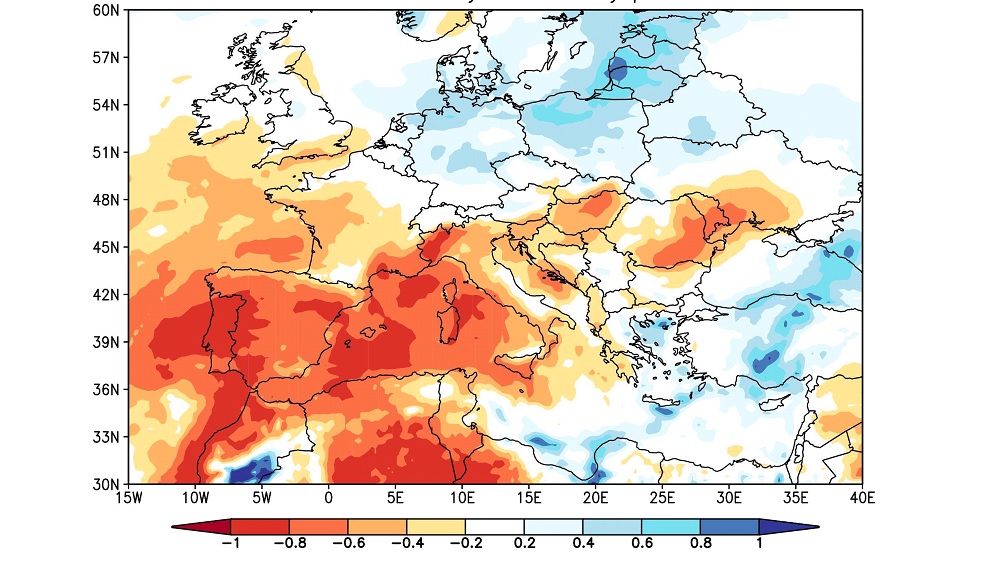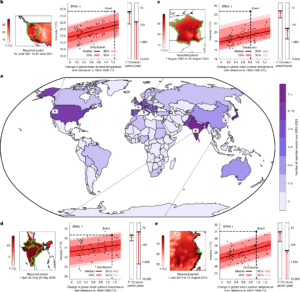WINTER DROUGHT IN THE MEDITERRANEAN: WHAT DO WE KNOW?
Summary
Since October 2021 and until mid march 2022, a severe drought has gripped the Western Mediterranean area, putting harvests from rain-fed crops potentially at risk. Winter is a crucial season for water resources in this region. What is the current state of our knowledge?
- The Mediterranean is considered a hotspot of climate change with climate models projecting year-round drying and enhanced warming in summer.
- Over the 20th century, the Mediterranean has seen substantial warming mostly attributable to anthropogenic climate change
- Less rainfall accumulates due to poleward migration of the subtropical jet and associated storm tracks. Moreover, warming leads to increased evapotranspiration decreasing soil moisture.
- The exact dynamical contribution to Mediterranean drying remains uncertain, as climate models show substantial disagreement on jet and storm track changes.
- Overall, the likelihood of extreme agricultural drought is projected to at least double with 1.5°C global warming above pre-industrial climate.

Figure 1: Precipitation anomalies defined as (PJan-Feb/Pclim – 1) with PJan-Feb the total precipitation over January-February 2022 and Pclim the climatological January-February precipitation over 1991-2020 (ERA5 reanalyses). Thus, white colored regions (values close to 0) received their climatologically expected rainfall, dark red regions (values close to -1) did not receive any rainfall at all, and orange colored regions (values close to -0.5) received about half their climatologically expected precipitation.
Amid record-low rainfall levels in Portugal, Spain and North Africa this winter, reservoirs are down and there are substantial worries of reduced or failed harvests if the drought continues throughout spring and summer. In the last three months of 2021, Spain recorded just 35% of the average 1981-2010 rainfall and there has been almost no rain in January/February 2022 (see Figure 1). The Moroccan average cumulative rainfall recorded from September 1, 2021 to February 28, 2022 was 42.5 mm, against a climatological normal of 129.5 mm (1981-2010 period), which represents a deficit of 67.2%. Also Morocco and parts of Algeria and Tunisia ended March exceptionally dry, running the risk of smaller harvests, making them even more dependent on foreign imports (see Figure 2). These drought-related agricultural risks are thus particularly worrying given the current geopolitical situation which has resulted in record-high food prices.

Figure 2: Drought monitor by the Joint Research Center (JRC) as of March 2022, https://edo.jrc.ec.europa.eu
A hotspot of climate change
The Mediterranean is considered a “hotspot” of climate change with climate models projecting long-term winter drying and enhanced warming in summer. The mediterranean regions accumulate a large number of changes in climatic impact-drivers (IPCC AR6, WGI, CH12). Impacts from climate change can already be felt today: Droughts and heat waves have contributed to water shortages, wildfires, and crop-failures1–3. The 1998-2012 drought in the eastern Mediterranean has been documented to be the worst in 900 years4, increasing water scarcity and causing crop failure and livestock mortality. Mediterranean agriculture is particularly vulnerable to such extremes as crop production is largely water limited5.
In winter, the North Atlantic Oscillation (NAO) primarily determines the jet-position over the Atlantic and thereby the amount of Mediterranean rainfall. The NAO has strong internal variability but is also influenced by the stratospheric polar vortex8, Atlantic sea surface temperatures and possibly Arctic sea-ice10 and Eurasian snow-cover11. The NAO has been in a positive phase since early January until the end of March, favoring dry conditions over the Mediterranean. In April the NAO was mostly in a negative state which has brought rainfall to some drought-affected regions, notably Spain.
Climate models robustly project drying and enhanced warming under greenhouse gas forcing, making the Mediterranean a key hotspot of climate change that is at risk of desertification5. Climate model projections (CMIP6) show a decrease in Mediterranean precipitation, similar to other sub-tropical regions like Central America, Southern Africa, Southern Australia. This is partly related to a poleward extension of sub-tropical dry zones associated with a poleward migration of the Jetstream and storm tracks. In boreal winter, climate models show a general northward shift of storm tracks reducing the number of storm systems that bring rainfall to the Mediterranean region. Still there is substantial uncertainty, as for the North Atlantic region there is generally low agreement between CMIP6 models with respect to jet and storm track changes. Apart from these dynamical changes leading to reduced precipitation, warming will lead to increased evapotranspiration due to an enhanced atmospheric water demand. This will decrease soil moisture over the Mediterranean region (high confidence).
These long-term greenhouse-gas forced trends are already detectable in the observational data. The 6th IPCC (WGI) Assessment report states that agro-ecological droughts in mediterranean regions have increased due to climate change (medium confidence) (see figure below) and hydrological droughts have increased with high confidence. In particular, over the 20th century, the Mediterranean has seen substantial winter drying mostly attributable to anthropogenic climate change2, and drought spells have doubled in likelihood6. Reductions in winter rainfall have a drying effect on soils in summer which can magnify heat extremes due to the lack of evaporative cooling7. This inter-seasonal dependence might favor compound extremes in the form of multi-year hot-dry periods. The IPCC WG2 reports that at 1.5°C global warming above pre-industrial climate[1], the likelihood of extreme agricultural (soil moisture) drought is projected to at least double, i.e. an increase by at least 100%. As a consequence, yields of rain-fed crops may decrease by 64% in some locations (high confidence). This long-term trend towards drier conditions is also a key driver behind increased wildfire risks in Mediterranean Europe, which are projected to increase with high confidence by mid century.
Within project XAIDA we will study climatic drivers of Mediterranean drought using machine learning techniques based on causal discovery. This should give us a better understanding of the dynamical processes leading to droughts such that we can make confident attribution statements and identify key risks for the region. These risks will form the basis of physically plausible storylines of Mediterranean drought and its impacts on society.

Figure 3: Synthesis of assessment of observed change in agricultural and ecological drought with the Mediterranean indicated by MED (From IPCC AR6 WGI)
[1] The current global warming level over the last decade relative to 1850-1900 is estimated to 1.1°C
References
1.Daccache, A., Ciurana, J. S., Rodriguez Diaz, J. A. & Knox, J. W. Water and energy footprint of irrigated agriculture in the Mediterranean region. Environ. Res. Lett. 9, 124014 (2014).
2.Hoerling, M. et al. On the increased frequency of mediterranean drought. J. Clim. 25, 2146–2161 (2012).
3.Tedim, F., Remelgado, R., Borges, C., Carvalho, S. & Martins, J. Exploring the occurrence of mega-fires in Portugal. For. Ecol. Manage. 294, 86–96 (2013).
4.Cook, B. I., Anchukaitis, K. J., Touchan, R., Meko, D. M. & Cook, E. R. Spatiotemporal drought variability in the Mediterranean over the last 900 years. J. Geophys. Res. Atmos. 121, 2060–2074 (2016).
5.Guiot, J. & Cramer, W. The 2015 Paris Agreement thresholds and Mediterranean basin ecosystems. Science (80-. ). 354, 465–468 (2016).
6.Kelley, C. P., Mohtadi, S., Cane, M. A., Seager, R. & Kushnir, Y. Climate change in the Fertile Crescent and implications of the recent Syrian drought. Proc. Natl. Acad. Sci. 112, 3241–3246 (2015).
7.Hirschi, M. et al. Observational evidence for soil-moisture impact on hot extremes in southeastern Europe. Nat. Geosci. 4, 17–21 (2010).
8.Baldwin, M. P. et al. Stratospheric Memory and Skill of Extended-Range Weather Forecasts. Science (80-. ). 301, 636–640 (2003).
9.Czaja, A., Frankignoul, C., Czaja, A. & Frankignoul, C. Observed Impact of Atlantic SST Anomalies on the North Atlantic Oscillation. J. Clim. 15, 606–623 (2002).
10.Pedersen, R. A. et al. The Impact of Regional Arctic Sea Ice Loss on Atmospheric Circulation and the NAO. J. Clim. 29, 889–902 (2016).
11.Brands, S., Manzanas, R., Gutiérrez, J. M. & Cohen, J. Seasonal predictability of wintertime precipitation in Europe using the snow advance index. J. Clim. 25, 4023–4028 (2012).
 This project has received funding from the European Union’s Horizon 2020 research and innovation programme under grant agreement No 101003469.
This project has received funding from the European Union’s Horizon 2020 research and innovation programme under grant agreement No 101003469.
Archives

Climate Extremes & Societal Risks

Paper: Systematic attribution of heatwaves to the emissions of carbon majors

